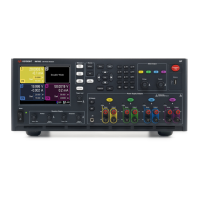[SOURce:]ARB:SEQuence:STEP:FUNCtion:SHAPe <function>, <step#>, (@<chanlist>)
[SOURce:]ARB::SEQuence:STEP:FUNCtion:SHAPe? <step#>, (@<chanlist>)
Creates a new Arb sequence step or changes the waveform of an existing sequence step. The
maximum number of steps that can be programmed is 100. The following waveforms may be assigned
to a sequence step:
STEP Specifies a step
RAMP Specifies a ramp
STAircase Specifies a staircase
SINusoid Specifies a sinewave
PULSe Specifies a pulse
TRAPezoid Specifies a trapezoid
EXPonential Specifies a exponential waveform
UDEFined Specifies a user-defined waveform
CDWell Specifies a constant-dwell waveform
SEQuence Specifies a sequence of arbitrary waveforms
NONE Specifies no arbitrary waveform
Parameter Typical Return
STEP | RAMP | STAircase | SINusoid | PULSe | TRAPezoid | EXPonential
| UDE:Fined | CDWell | SEQuence |NONE, *RST NONE
STEP, RAMP, STA, SIN, PULS, TRAP, EXP,
or UDEF.
Step 0 - 99, *RST 0 (none)
Specify a shape for sequence step 1: ARB:SEQ:STEP:FUNC:SHAP SIN, 1, (@1)
l If the <step#> specified is an existing sequence step, that step will be changed to the specified
waveshape with all parameters reset to default values.
l New sequence steps must be specified sequentially. To create a new sequence step, <step#>
should be specified to be the current length of the sequence (see
[SOURce:]ARB:SEQuence:LENgth?). When a step is added, all parameters of the step waveform
are reset to their default values.
[SOURce:]ARB:SEQuence:STEP:PACing <pacing>, <step#>, (@<chanlist>)
[SOURce:]ARB::SEQuence:STEP:PACing? <step#>, (@<chanlist>)
Specifies the type of pacing for the specified step number as follows:
DWELl When dwell paced, the step moves to the nextstep when the dwell timeis finished.
TRIGgered When trigger paced, the step waits at the last value of the step until a trigger is received. The next step is started upon receiptof
the trigger.
Keysight N6705C Operating and Service Guide 265
7 SCPI Programming Reference

